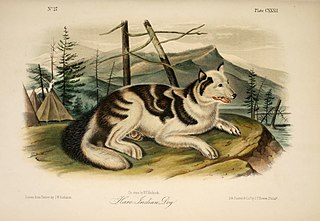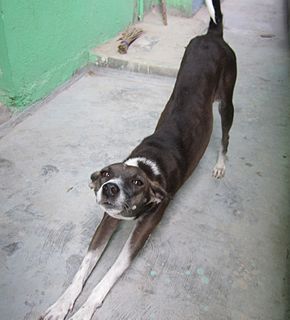
A pet, or companion animal, is an animal kept primarily for a person's company or entertainment rather than as a working animal, livestock or a laboratory animal. Popular pets are often considered to have attractive appearances, intelligence and relatable personalities, but some pets may be taken in on an altruistic basis and accepted by the owner regardless of these characteristics.

The dingo is an ancient (basal) lineage of dog found in Australia. Its taxonomic classification is debated; as per the variety of scientific names presently applied in different publications, it is variously considered a form of domestic dog not warranting recognition as a subspecies; a subspecies of dog and/or wolf; or a full species in its own right.

A 'dog breed' is a particular strain or dog type that was purposefully bred by humans to perform specific tasks, such as herding, hunting, and guarding. When distinguishing breed from type, the rule of thumb is that a breed always "breeds true". Dogs are the most variable mammal on earth, with artificial selection producing around 450 globally recognized dog breeds. These breeds possess distinct traits related to morphology, which include body size, skull shape, tail phenotype, fur type, and coat colour. Their behavioural traits include guarding, herding, and hunting, and personality traits such as hypersocial behavior, boldness, and aggression. Most breeds were derived from small numbers of founders within the last 200 years. As a result, today dogs are the most abundant carnivore species and are dispersed around the world.

Domestication is a sustained multi-generational relationship in which one group of organisms assumes a significant degree of influence over the reproduction and care of another group to secure a more predictable supply of resources from that second group. The domestication of plants and animals was a major cultural innovation ranked in importance with the conquest of fire, the manufacturing of tools, and the development of verbal language.

Indigenous Canadians are the indigenous peoples within the boundaries of Canada. They comprise the First Nations, Inuit and Métis. Although "Indian" is a term still commonly used in legal documents, the descriptors "Indian" and "Eskimo" have fallen into disuse in Canada, and some consider them to be pejorative. "Aboriginal" as a collective noun is a specific term of art used in some legal documents, including the Constitution Act, 1982, though in some circles that word is also falling into disfavour.

A totem is a spirit being, sacred object, or symbol that serves as an emblem of a group of people, such as a family, clan, lineage, or tribe.

A wolfdog is a canine produced by the mating of a domestic dog with a gray wolf, eastern wolf, red wolf, or Ethiopian wolf to produce a hybrid.
Dog intelligence or dog cognition is the process in dogs of acquiring information and conceptual skills, and storing them in memory, retrieving, combining and comparing them, and using them in new situations.
A bark is a sound most commonly produced by dogs. Other animals that make this noise include wolves, coyotes, seals, foxes, and quolls. Woof is the most common onomatopoeia in the English language for this sound, especially for large dogs. "Bark" is also a verb that describes the sharp explosive cry of certain animals.

Salvage ethnography is the recording of the practices and folklore of cultures threatened with extinction, including as a result of modernization. It is generally associated with the American anthropologist Franz Boas; he and his students aimed to record vanishing Native American cultures. Since the 1960s, anthropologists have used the term as part of a critique of 19th-century ethnography and early modern anthropology.

The domestication of animals is the mutual relationship between animals and the humans who have influence on their care and reproduction.
The domestic dog is a domesticated descendant of the wolf. The dog derived from an ancient, extinct wolf, and the modern grey wolf is the dog's nearest living relative. The dog was the first species to be domesticated, by hunter–gatherers over 15,000 years ago, before the development of agriculture. Their long association with humans has led dogs to be uniquely adapted to human behavior, leading to a large number of domestic individuals and the ability to thrive on a starch-rich diet that would be inadequate for other canids.

The origin of the domestic dog includes the dog's genetic divergence from the wolf, its domestication, and the emergence of the first dogs. Genetic studies show that all ancient and modern dogs share a common ancestry and descended from an ancient, now-extinct wolf population - or closely related wolf populations - which was distinct from the modern wolf lineage. The dog's similarity to the extant grey wolf is the result of substantial dog-into-wolf gene flow, with the modern grey wolf being the dog's nearest living relative. An extinct Late Pleistocene wolf may have been the ancestor of the dog, with one study proposing that this Pleistocene wolf was closer in size to a village dog.

Dog behavior is the internally coordinated responses of individuals or groups of domestic dogs to internal and external stimuli. It has been shaped by millennia of contact with humans and their lifestyles. As a result of this physical and social evolution, dogs, more than any other species, have acquired the ability to understand and communicate with humans, and they are uniquely attuned in these fellow mammals. Behavioral scientists have uncovered a wide range of social-cognitive abilities in the domestic dog.
Self-domestication is the process of adaptation of wild animals to cohabiting with humans, without direct human selective breeding of the animals. Dogs and cats have undergone this kind of self-domestication. Self-domestication also refers to the evolution of hominids, particularly humans and bonobos, toward collaborative, docile behavior. As described by British biological anthropologist Richard Wrangham, self-domestication involves being in an environment that favors reduction in aggression, including interspecific and intraspecific antagonism, for survival. Spandrels, or evolutionary byproducts, also accompany self-domestication, including depigmentation, arrested development, and reduced sexual dimorphism.

The Hare Indian dog is an extinct domesticated canine; possibly a breed of domestic dog, coydog, or domesticated coyote; formerly found and originally bred in northern Canada by the Hare Indians for coursing. It had the speed and some characteristics of the coyote, but the domesticated temperament and other characteristics of a domestic dog. It gradually lost its usefulness as aboriginal hunting methods declined, and became extinct or lost its separate identity through interbreeding with dogs in the 19th century, though some claim the breed still exists in modified form.

Two-Spirit is a modern, pan-Indian, umbrella term used by some Indigenous North Americans to describe Native people in their communities who fulfill a traditional third-gender ceremonial and social role in their cultures.

A free-ranging dog is a dog that is not confined to a yard or house. Free-ranging dogs include street dogs, village dogs, stray dogs, feral dogs, etc., and may be owned or unowned.
Becerrillo or Bezerrillo was the name of a Castilian attack dog during the time of the Spanish conquistadors.

The Paleolithic dog was a Late Pleistocene canine. They were directly associated with human hunting camps in Europe over 30,000 years ago and it is proposed that these were domesticated. They are further proposed to be either a proto-dog and the ancestor of the domestic dog or an extinct, morphologically and genetically divergent wolf population.













